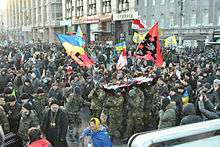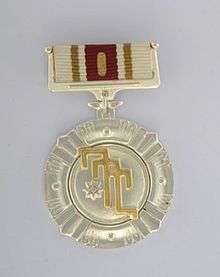Ukrainian National Assembly – Ukrainian People's Self-Defence
Ukrainian National Assembly Українська Національна Асамблея | |
|---|---|
 | |
| Founded | 3/4 November 1990 |
| Dissolved | 22 May 2014[1] (Political wing only.[1]) |
| Merged into | Right Sector[1] (Political wing only.[1]) |
| Headquarters | Kiev |
| Paramilitary Wing | Ukrainian National Self Defense |
| Membership (2006) | 8,000[2] |
| Ideology | Ukrainian nationalism |
| Political position | Far-right[3][4] |
| International affiliation | None |
| Colours | Red, black |
| Party flag | |
 | |
| Website | |
|
una-unso | |
The Ukrainian National Assembly – Ukrainian People's Self-Defence (Ukrainian: Українська Національна Асамблея-Українська Народна Самооборона , УНА-УНСО, UNA-UNSO) is a Ukrainian political organisation seen as far-right in Ukraine and abroad.[5][6] Although the Ukrainian National Assembly (Ukrainian: УНА, UNA) was the organisation's political wing, on 22 May 2014 it merged with Right Sector;[1] the UNA-UNSO continues to operate independently. According to Andreas Umland and Anton Shekhovtsov, the UNSD was created in 1991 as a "formation manned by UNA members who had served in the Soviet armed forces ... to confront the State Committee for the State of Emergency".[7]
History
Early years
The UNA was created on 30 June 1990 in Lviv as the Ukrainian Interparty Assembly (UMA),[8] led by maverick politician and nationalist writer Dmytro Korchynsky. On 3–4 November 1990, a congress of the Ukrainian National Association (UNS) was held in Kiev. On 11 January 1991, UNS squads headed by Yuriy Tyma guarded the Seimas Palace during the January Events in Lithuania. On 30 June 1991, about 200 UNS members held a torchlight parade in Lviv commemorating the 1941 declaration of Ukrainian independence.
During the first days of the 1991 Soviet coup d'état attempt, a UNS squad led by Vietnam War veteran Valeriy Bobrovych left for Moscow; the squad later laid the foundations for the Argo battalion. On 19 August 1991, during the struggle against the State Committee on the State of Emergency, the UNS created squads of the Ukrainian People's Self-Defense (UNSO) in Kiev. The squads were formed around a small group of ethnic-Ukrainian Soviet army veterans of the war in Afghanistan. In December 1990 Yuriy Shukhevych, the son of Roman Shukhevych, was elected as the first leader of the UNS.[8] Because of the 8 September 1991 Declaration of Independence of Ukraine, the sixth session of the UMA was renamed the Ukrainian National Assembly; it became known as the UNA-UNSO, due to the UNSO's close association with the UNA.[8]
Since its 1991 independence, Ukraine has had separatist movements aiming to reunite portions of Ukraine with Russia and other neighbouring countries. UNA-UNSO stopped People's Deputy Goncharov of the Supreme Soviet of the Soviet Union from reestablishing the Donetsk–Krivoy Rog Soviet Republic and the Donetsk National Guard in the Donbass. In Kiev, the Patriotic Forum (Otyechestvyennyi forum) was abolished. In November 1991 the UNSO held a rally, and due to a brawl involving UNSO fighters the government made the first mass arrests of UNSO activists. In Odessa UNSO halted an initiative to create a Novorossiysk Republic, influencing separatist movements in Bukovina and Zakarpattia. On 7 June 1992, an UNSO group from Lviv broke up a Romanian congress in Chernivtsi which advocated the unification of northern Bukovina and Romania. In early 1993, the UNSO had a reported 4,000 members.[8]
Since 1994
The UNA was registered as a political party in December 1994,[8] and in the 1994 Ukrainian parliamentary election three UNA-UNSO members were elected as deputies to the Verkhovna Rada (Ukrainian parliament). In September 1995, its registration was suspended until 1997.[8]
UNSO was registered as a public organization in Lviv, Ternopil, Rivne and Poltava Oblasts only.[8] In practise, however, there was no distinction between the membership of both organizations.[8]
From 1994 to 1997, UNA-UNSO members became prominent in Ukraine through a number of anti-Russian activities. UNA-UNSO deputies destroyed a Russian flag in the Verkhovna Rada, UNA-UNSO fighters joined Chechen rebels in the First Chechen War and activists organised demonstrations against Russian pop singers visiting Ukraine. UNA-UNSO took sides in Ukrainian church affairs and clashed with police during the July 1995 funeral of Patriarch Volodomyr, head of the Ukrainian Orthodox Church of the Kyivan Patriarchate. The organisations supported Patriarch Filaret Denysenko, who was excommunicated by the Russian Orthodox Church, and participated in violent attempts to seize property for the new church (particularly in Rivne and Volyn Oblasts. Membership peaked at around 10,000 members, about 90 percent of whom were between 18 and 35 years old. The organisation was depicted in Georgiy Gongadze's 1994 documentary film, Shadows of War.
In 1997, the government of Leonid Kuchma banned the Ukrainian National Assembly – Ukrainian National Self Defence. UNA-UNSO members responded with violent street protests, resulting in over 250 arrests. Dmytro Korchynsky, one of those arrested, soon left the organisation.
In 1998 UNA-UNSO's new leaders were Andriy Shkil and Yuriy Shukhevych, the son of Ukrainian nationalist Roman Shukhevych. In the 1998 Ukrainian parliamentary election, the organisation received 0.39 percent of the vote.[9]
Ukrainian National Assembly – Ukrainian Nationalistic Self Defense members participated in the 2000–01 Ukraine without Kuchma protest campaign. In the 2002 parliamentary elections Andriy Shkil won an electoral district in Lviv Oblast and a seat in the Verkhovna Rada,[10][11] the party itself won 0.04% of the votes.[9] In 2003 Shkil left the party,[12] and he has become an aide to Yulia Tymoshenko.[13][14] During the Orange Revolution UNA-UNSO members supported Viktor Yushchenko against his pro-Russian opponents, providing security for Yushchenko supporters and Orange leaders such as Yulia Tymoshenko in Kiev's Independence Square.[15]

In 2005, Yuriy Shukhevych again became the party's leader. In the 2006 parliamentary election, it failed to win parliamentary representation with 0.06 percent of the vote[9] and did not participate in the 2007 election.[9]
In 2008 South Ossetian attorney general Teimuraz Khugayev accused UNA-UNSO of joining a Georgian unit during the August war, but no evidence has been provided.[16] According to an August 2009 Russian Investigative Committee report, 200 UNA-UNSO members and soldiers from the Ukrainian Ground Forces aided Georgia during the fighting. Ukraine denied the accusation. UNA-UNSO deputy head Nikolay Karpyuk said that "unfortunately", no organisation members took part in the Georgian conflict.[17]
UNA-UNSO participated in the 2012 Ukrainian parliamentary election,[18] receiving 0.08 percent of the national vote and winning none of the five electoral districts in which they fielded candidates.[19]) and thus failed to win parliamentary representation.[20]
In March 2014 Russia brought a criminal case against the party and some of its members, including party leader Oleh Tyahnybok) of Svoboda, for "organizing an armed gang" which allegedly fought the Russian 76th Guards Air Assault Division during the first Chechen war.[21] The organisation's Ukrainian National Assembly political wing merged with Right Sector on 22 May 2014.[1]
Leaders
- 1990-1994 Yuriy Shukhevych
- 1994-1999 Oleh Vitovych
- 2002-? Andriy Shkil
- 2005- Yuriy Shukhevych
- 2015-2016 Kostiantyn Fushtei
- 2016[22] - Valeriy Bobrovych
International conflicts
- January Events in Lithuania (1991)
- 1991 Soviet coup d'état attempt in Moscow (summer 1991)
- Transnistria War in Moldova (spring-summer 1992)
- War in Abkhazia (1992–93)
- First Chechen War in Russia (1995-1996)
- Kosovo War in Yugoslavia (1998-1999)
Transnistria

During the Transnistria War, UNA-UNSO members fought with Transnistrian separatists against Moldovan government forces[23] in defence of a large ethnic-Ukrainian minority in Transnistria.[8] Over 50 UNSO members were awarded the Defender of Transnistria Order.
Georgian civil war
In 1993, UNA-UNSO sent volunteers to the Abkhaz–Georgian conflict against Abkhaz separatists.[24][25] The UNA-UNSO Argo unit joined the Georgian side against Russian-backed Abkhaz forces, and some volunteers joined the Sukhumi Battalion of the Marine Infantry Forces of Georgia. A CPT Ustym squad prevented an amphibious assault of Russian forces near Sukhumi, sinking a Russian military motorboat. Seven UNSO members died near Sukhumi, and 30 members received the Order of Vakhtang Gorgasali medal.
- Sukhumi raid (June 1993)
- Starushkino village ambush (15 July 1993)
- Shromi village assault (17 July 1993)
- Khomi defence (4 October 1993)
- Samtredia defence (17 October 1993)
Ideology and image
The Ukrainian National Assembly – Ukrainian People's Self-Defence 1994 party platform envisioned Kiev as the centre of a new, Pan-Slavic, eastern military bloc.[8] International-security expert Andrew McGregor said in 2006 that the UNA-UNSO "might be best characterized as an influential fringe movement" and "its high visibility belies its limited numbers".[2] Its anthem is "Stay, my love, don't cry, honey", a reprise of "Bella ciao".[26]
Elections
| Parliamentary, since 1994 (year links to election page) | ||||||||
|---|---|---|---|---|---|---|---|---|
| Year | Votes | % | Mandate | |||||
| 1994 | |
|
| |||||
| 1998 | |
|
| |||||
| 2002 | |
|
| |||||
| 2006 | |
|
| |||||
| 2007 | |
|
| |||||
| 2012 | |
|
| |||||
UNA-UNSO parliamentarians
- Yuriy Tyma
- Andriy Shkil
See also
References
- 1 2 3 4 5 6 Right Sector registered as official party, Interfax-Ukraine (22 May 2014)
- 1 2 McGregor, Andrew (30 March 2006), Radical Ukrainian Nationalism and the War in Chechnya, The Jamestown Foundation
- ↑ Wilson, Andrew (2005), Ukraine's Orange Revolution, Yale University Press, p. x
- ↑ Ramet, Sabrina P. (1998), Nihil Obstat: Religion, Politics, and Social Change in East-Central Europe and Russia, Duke University Press, p. 257
- ↑ Singh, Anita Inder (2001), Democracy, Ethnic Diversity, and Security in Post-Communist Europe, Greenwood, p. 114
- ↑ Dymerskaya-Tsigelman, Liudmila; Finberg, Leonid (1999), "Antisemitism of the Ukrainian Radical Nationalists: Ideology and Policy", Analysis of Current Trends in Antisemitism, Vidal Sassoon International Center for the Study of Antisemitism (14)
- ↑ Umland, Andreas; Shekhovtsov, Anton (September–October 2013). "Ultraright Party Politics in Post-Soviet Ukraine and the Puzzle of the Electoral Marginalism of Ukrainian Ultranationalists in 1994–2009". Russian Politics and Law. 51 (5): 33–58. doi:10.2753/RUP1061-1940510502.
- 1 2 3 4 5 6 7 8 9 10 The radical right in Central and Eastern Europe since 1989 by Sabrina Ramet, Pennsylvania University Press. 1999 ISBN 0-271-01810-0 (page 290 and continuing from there)
- 1 2 3 4 (in Ukrainian) Українська національна Ассамблея, Database DATA
- ↑ The Constituency № 121, Central Election Commission of Ukraine (2002 regular election)
- ↑ Results of voting in single-mandate constituencies, Central Election Commission of Ukraine (2002 regular election)
- ↑ "A brief course of UNA-UNSO history UNA-UNSO :: Articles". Retrieved 3 March 2015.
- ↑ Yulia Tymoshenko’s orbits / Ukrayinska Pravda
- ↑ The Makeup of the New Verkhovna Rada / Ukrayinska Pravda
- ↑ Far-right Group Flexes During Ukraine "Revolution", Associated Press, 1 January 2005]
- ↑ Allenova, Olga (25 November 2008). "Foreign Traces in the Strange War". Kommersant. Retrieved 30 November 2008.
- ↑ Ukrainian army supported Georgian attack on South Ossetia, RT (TV network) (24 August 2009)
- ↑ (in Ukrainian) Відомості щодо реєстрації виборчих списків кандидатів у депутати Information on the registration of electoral lists of candidates, Central Election Commission of Ukraine
- ↑ (in Ukrainian) Candidates, RBC Ukraine
- ↑ (in Ukrainian) Proportional votes & Constituency seats, Central Election Commission of Ukraine
- ↑ "Russia launches criminal case against Ukraine's Tiahnybok". Interfax-Ukraine. Retrieved 30 October 2014.
- ↑ Head of the UNA-UNSO party became Valeriy Bobrovych (Головою партії УНА-УНСО став Валерій Бобрович). UNA-UNSO party. 7 November 2016.
- ↑ "УНСО". УНСО. Retrieved 3 March 2015.
- ↑ Democratic Changes and Authoritarian Reactions in Russia, Ukraine, Belarus and Moldova (Democratization and Authoritarianism in Post-Communist Societies), Cambridge University Press, 1997, ISBN 0521597323 (page 349)
- ↑ State Building and Military Power in Russia and the New States of Eurasia (International Politics of Eurasia), M. E. Sharpe, 1995, ISBN 1563243601 (page 173)
- ↑ (in Ukrainian) УНСО, YouTube
External links
- UNA-UNSO Official party web page
- The rise and fall of a radical movement - Kyiv Post (8 November 2001)
- Koroliuk, Yu. Petrels of Revolution: Ukrainian nationalist organization UNA - UNSO - five years. Nezavisimaya Gazeta. 28 November 1995
- Brief historical outlook on establishment of UNA-UNSO
